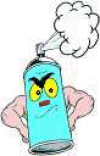

Chlorofluorocarbons
 Chlorofluorocarbons or CFCs (also known as Freon) are non-toxic, non-flammable and non-carcinogenic. They contain fluorine atoms, carbon atoms and chlorine atoms. The 5 main CFCs include CFC-11 (trichlorofluoromethane - CFCl3), CFC-12 (dichloro-difluoromethane - CF2Cl2), CFC-113 (trichloro-trifluoroethane - C2F3Cl3), CFC-114 (dichloro-tetrfluoroethane - C2F4Cl2), and CFC-115 (chloropentafluoroethane - C2F5Cl).
Chlorofluorocarbons or CFCs (also known as Freon) are non-toxic, non-flammable and non-carcinogenic. They contain fluorine atoms, carbon atoms and chlorine atoms. The 5 main CFCs include CFC-11 (trichlorofluoromethane - CFCl3), CFC-12 (dichloro-difluoromethane - CF2Cl2), CFC-113 (trichloro-trifluoroethane - C2F3Cl3), CFC-114 (dichloro-tetrfluoroethane - C2F4Cl2), and CFC-115 (chloropentafluoroethane - C2F5Cl).
CFCs are widely used as coolants in refrigeration and air conditioners, as solvents in cleaners, particularly for electronic circuit boards, as a blowing agents in the production of foam (for example fire extinguishers), and as propellants in aerosols. Indeed, much of the modern lifestyle of the second half of the 20th century had been made possible by the use of CFCs.
Man-made CFCs however, are the main cause of stratospheric ozone depletion. CFCs have a lifetime in the atmosphere of about 20 to 100 years, and consequently one free chlorine atom from a CFC molecule can do a lot of damage, destroying ozone molecules for a long time. Although emissions of CFCs around the developed world have largely ceased due to international control agreements, the damage to the stratospheric ozone layer will continue well into the 21st century.
 | Uses of CFCs |
Websites
Other topics
• Ozone Depletion
• Ozone Depletion
• US EPA
• Hong Kong Education
• Trane
• Introduction
• Antarctica
• Arctic
• Causes
• CFCs
• Doing Our Bit
• Evidence
• Eye Disorders
• Global Climate
• Human Health
• Immune System
• Impacts
• Land Plants
• Legislation
• Materials Damage
• Measuring
• Monitoring
• Montreal Protocol
• ODCs
• Ozone
• Ozone Hole
• Ozone Layer
• Polar Vortex
• Protection
• PSCs
• Sea Life
• Skin Cancer
• Stratosphere
• Sun
• UV Radiation
• Volcanoes
 Print Topic
Print Topic